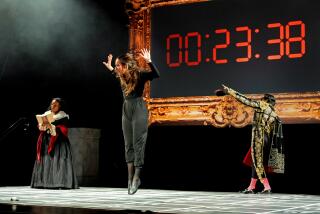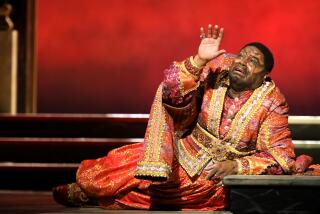Review: ‘Sweet Land’ triumphantly moves online. It’s the best ticket in opera right now
“Sweet Land,” the widely celebrated opera mounted by the Industry during the last weekend of February and the first weekend of March at Los Angeles State Historic Park, was performance of place and of the moment. The setting was the work. You had to be there.
The opera was designed as immersive art, and you needed to feel it physically. The experience was meant to be personal. Another aspect of its essence was disappearance. Here was fragility amplified. After two additional weekends of performances, all traces of the sets were meant to vanish into thin air.
Those final weekends were wiped out by the pandemic. The park closed. Yet an operatic butterfly with a lifespan of a month lives. It has mutated into a video opera. Cast and crew returned for a shoot on March 15, and on Sunday the video was released for on-demand steaming via Vimeo.
What Yuval Sharon, the founder and artistic director of the Industry and the mastermind of “Sweet Land,” has done is make a video that is a very different experience from attending in person. If you saw the park staging, originally co-directed by Sharon and Cannupa Hanska Luger, this shows you what you missed. If you weren’t, this shows you what you are no longer missing.
An opera of place has become an opera of stay in place. An opera of physical immersion has become an opera of aural immersion. (I recommend listening with headphones.) An opera that was meant to be a very strong communal experience has become, as our quarantined lives have, utterly personal. An opera about the spirit of the land has become, itself, a spirit in the digital ether rather a physical presence.
Most of all, an opera about disappearance has refused to disappear.
When performed live, there were two versions of “Sweet Land,” with common points. The audience sat in bleachers for the opening spectacle of immigrant Arrivals coming to Sweet Land, greeted and fed by native Hosts attempting to attune the newcomers to the spiritual needs of nature.
Then half of the audience saw “Feast,” in which the Arrivals turn on their hosts as the countertenor outlaw Jimmy Gin violently takes the beautiful Makwa against her will. The other half saw “Train,” in which the Hosts attempt to guide the Arrivals in the ways of the land, only to have that used against them as their captors propulsively ravish the Earth. At the end, the audiences from both parts returned to the bleaches for a bleak look at that ravishment.
There were hundreds of ways of making the experience of “Sweet Land” entrancing. Los Angeles was seen physically from a new angle. There were dazzling visuals, particularly a central scene with mischievously mystical creatures in front of magically mysterious projections on mists of water from sprinklers. Only audience members capable of muscling their way to the front of the crowd could see more than the bits everyone else could catch by craning heads.
During other parts of the performance you were hit by stimuli from so many sides you never quite knew what was what. With so much going on, the sheer barrage on the senses meant that everybody had a different experience. That was the point. You had to let it sink in. Trying to see each 90-minute part, “Feast” and “Train,” on the same night was a bad idea. This was an opera of commitment. Through it all, the music was but one part.
Watching and listening to the video version, you can’t help but notice the music and libretto taking the central place they occupied all along, even if that required more than one sitting to comprehend. “Sweet Land” was shot and recorded on a single evening and edited in a mere two weeks, but the sound and editing are so superb that, by itself, the soundscape creates the landscape.
There was never any question that the performances, both the instrumental ensembles for each part and the arresting singers, were terrific. But experiencing all of that close-up shows just how terrific.
Then there is the score by the composers Raven Chacon and Du Yun. Here is how you can tell this is real opera — its bones, blood, sinew, skin and consciousness all in the music. The experience that seemed more than complete outside was that only because all along it was the score that gave everything else meaning.
The music is complex. Chacon draws on his Native American roots, Du on her Chinese émigré ones. Both composers are highly adept in avant-garde instrumental and vocal techniques. Both have a sophisticated understanding of electronics. Repeated listening reveal scores with layers upon layers of coexisting elements that include a host of musical traditions, be they from Baroque opera or various kinds of spiritual ceremonies.
However different the two composers’ personalities, they together unveil the unexpected, unique American melting pot of now. The video — which is beautifully shot, by the way — is also a better way to appreciate the poetic texts by the librettist Aja Couchois Duncan and Douglas Kearney. For them, cultural anger and arresting imagery also potently meld.
“Feast” and “Train” have been edited down to around an hour each. That mystical central section, clearly not meant for the video screen, is now a brief two minutes of effective collage. The final scene, reduced to just a small boy on ravished land, has an emotional power all its own.
The Industry, for which the loss of revenue from the cancellation of “Sweet Land” poses an existential threat, has hoped to make something back by pricing “Sweet Land” at $14.99. (To watch, go to theindustryla.org.) It is the single best deal in all of opera right now, and that is taking into account the sudden riches of free opera streams from the world’s most illustrious companies.
More to Read
The biggest entertainment stories
Get our big stories about Hollywood, film, television, music, arts, culture and more right in your inbox as soon as they publish.
You may occasionally receive promotional content from the Los Angeles Times.







